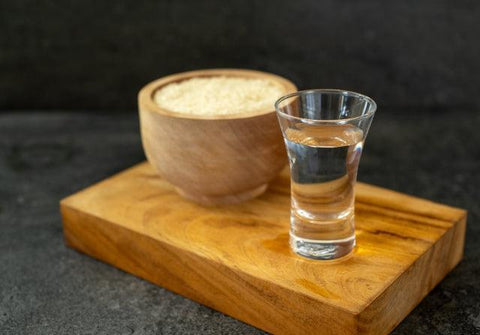
Jump to:
It is said that, for the most part, you get what you pay for with Nihonshu (used interchangeably with “sake” in this post). With wine, for example, unless you are a true wine buff, you are equally likely to be pleasantly surprised by a cut-priced discovery or dismayed by an overpriced monstrosity. But there is little snobbery when it comes to sake pricing and there is generally a close connection between the cost of the raw materials and the price of the bottle on the shelf.
Does that mean you will find everything in a certain price range equally to your taste? By no means. This goes beyond a simple preference for “purer” sake with a higher polishing ratio or Junmai or non-Junmai. A myriad of factors affects the flavor of the sake produced. In this blog post, we’ll look at what sake actually is and how it differs from other forms of Japanese liquor. We’ll also explore how different choices made during the sake-making process affect the overall taste and price of the finished product.
Is Sake Rice "Wine"?

So, sake is rice wine, right? Well not really.
Nihonshu is a unique alcoholic drink made from rice, water, koji, and yeast (and sometimes distilled alcohol). Shochu, another popular form of alcohol from Japan, can have a whole host of things as its base, including sweet potato, barley, or buckwheat among others. Sake, though is always made of rice, and not just any old rice. More on this later. Another difference is that it is fermented, without being distilled like Shochu. You may suppose that if it is fermented it must be “wine”.
But when making sake, there is molding in addition to the fermentation as when making beer. So, sake is sort of “rice beer”? Wrong again. Fermentation and molding are two separate processes when making beer. With Nihonshu, there is something called “parallel fermentation”. This is just a fancy term for the molding and fermentation happening together. Not even all rice liquor is the same. Awamori, which can only be produced in Okinawa by law, uses long-grained rice rather than the short-grained Japonica rice that sake uses. It is also distilled like Shochu.
The Alcohol Content of Sake

If you look at the alcohol content on the bottle, you may also think of it as being in the wine camp because of its similar alcohol content. While slightly higher than wine, at 13-17%, the alcohol content is still a fair degree lower than its distilled Japanese liquor counterparts. Shochu is 25% proof while Awamori, at around 30-40%, is at vodka or tequila knockout levels. Its lower alcohol level is no accident. After the pressing stage, the alcohol content may be as high as 22%, and it is literally “watered-down” to make it more drinkable.
How is Sake Made?
So, how is sake made and how do the different choices made during the overall process affect the finished product's taste? We should start with the raw ingredients. The only ingredients used to manufacture sake are rice, water, koji, and (in the case of non-Junmai sake) distilled alcohol.
The Ingredients

First, you have the rice. Rice is just rice, right?
Well, not exactly. Sake is always made from Sakamai (or “sake rice”), and this is not the same as what you get with your miso soup. To start with, it is a good deal pricier. The main reason for this is that it is harder to grow, as its tall ear means that it is more exposed to the elements than other rice. Its grains are larger, and they are soft on the outside and hard on the inside. This enables it to absorb the koji mold more easily. Additionally, it has a higher ratio of starch in relation to protein and fat compared to table rice. It is separated more cleanly with the protein and fat on the outside and the starch on the inside. We’ll get into why this is useful for making sake in the section on polishing later.
And then there is the water. Pure water makes up approximately 80% of a bottle of sake and is used in all of the steps of sake brewing, so it is hardly surprising that the quality of the water is a big deal. Sake can be made from soft and hard water. Soft water gives the sake a mellower taste. Its lower mineral content means it ferments more slowly, generating more fruity aromas. The use of hard water, on the other hand, leads to a more robust, sharp, taste due to the accelerated fermentation process resulting from its higher mineral content. Whether hard or soft water is used, high iron and magnesium are kryptonite for good sake. They act as contaminants, discoloring the sake and disturbing its flavor and aroma.
Thirdly, we have the koji. The koji is moldy rice that contains enzymes (alpha-amylase and glucoamylase) for breaking down the starch into sugars. As we’ll touch on in more detail in the section looking at the koji-making process, the way koji is used is another highly important factor that defines the sake eventually produced.
To Add or Not to Add Distilled Alcohol – That is the Question
For Junmai sake, that is as far as it goes in terms of ingredients. For other sake, however, distilled alcohol (or Jozoshu) is added. This is essentially ethanol with a 95% purity level. So, if distilled alcohol is added, is the consumer just being short-changed? The Junmai-only brigade would say yes, and only Junmai is pure sake, and therefore superior. About 80% of all sake produced in Japan has Jozoshu added and it can provide a more robust, crisp taste with a lighter body. (Taste tests have also revealed that a high percentage of the “Junmai or nothing” crowd can’t actually tell the difference between the two.)
Polishing the Rice

Finally, all the ingredients are present, and it is time to get brewing. But wait! Before, we can actually brew the sake, we need to get everything ready first. The rice first needs to be polished. Why polish the rice? As mentioned earlier, with sake rice, the starch element of the rice is located in the center of the rice. Sake rice is expensive and the more of the outer layer you polish away, the less you have for making sake. Then again, these proteins and fats around the outside affect the taste and aroma of the sake, so the brewer must consider this balance between cost and the desired sake profile.
A percentage you will find on the sake bottle represents the polishing rate (or Seimeibuai). This represents the amount of the rice grain that remains after polishing rather than the amount that has been ground away. Therefore, a Seimeibuai of 60% means that 40% of the outer layer has been removed. This is how sake is graded. To achieve the highest rank of Daiginjo, the polishing ratio must not exceed 50%. The polishing limits for Ginjo and Honjoshu sake are 60% and 70%, respectively. Everything else is Futsushu (or normal sake). So the lower the Seimeibuai, the better the sake, right? Well, not necessarily. The lower polishing ratio of Ginjo and Daiginjo may give the sake more purity and make them easier to drink, but excessive polishing can strip away flavor and aroma characteristics, so there is a balance between purity and character.
Washing and Steaming

After polishing, the rice needs to be washed. Why wash the rice at this stage? Because polishing leaves residues that need to be removed. The rice also needs to be soaked for the desired amount of time so that it absorbs the correct amount of water before the next process. This is not a simple process, and the length of time it is soaked, and the temperature of the water will differ depending on the polishing ratio. The rice prepared this way is then steamed in a steel vat. Again, the devil is in the details. The way the rice is laid out for steaming and the amount of time it is left to dry off will affect the final brew.
Making the Koji

About 15-20% of the rice is cooled and used to make the rice koji. This is rice on which mold has been formed by sprinkling the mold Aspergillus oryzac. Most people think of mold as something to be avoided, but the way the brewmaster manipulates the mold in this process, lasting 2-3 days will affect the character of the sake. It is, therefore, considered an important skill to master, searching for the desired level of sweetness/dryness and umami. There are two main styles of propagating the mold on the rice, as well as methods that fall between the two stools. With Souhaze-gata, the mold is used more aggressively to cover the entire surface and penetrate deep inside. This creates more full-bodied sake. With Tsukihase-gata, on the other hand, the surface of the rice is covered more sparsely, leading to more delicate flavors. How aggressive the propagation is will affect the degree to which proteins are broken down into amino acids. Again, balance is the key. Amino acids provide richness and umami, but too much can detract from the taste.
Brewing the Sake

After the preparation stage described above is complete, the actual brewing process begins. A small amount of the prepared ingredients are mixed together in a starter tank with water and yeast. This is the Shubo-making stage, during which the yeast starter is produced. This process will last at least two weeks, during which the temperature is carefully monitored. Lactic acid is also added which allows yeast to develop while killing off bad microbes that are weak against acid. This process creates the moto or base to be used in the Moromi (or “main mash”).
The Mash

Once the yeast starter is complete, the other ingredients are added over several days to make the mash in ever-increasing amounts in a three-stage process known as Sandan-jikomi. This is added in stages to allow the yeast to develop in a stable manner, without being overwhelmed by the sugar. Why not chuck it all in together and be done with it? Well, adding too much too quickly would thin out the mixture too much and make the yeast vulnerable to other organisms that would affect the taste. It is then left for 2-4 weeks to ferment. As mentioned earlier, parallel fermentation occurs where the conversion of starch to sugar and sugar to alcohol occurs simultaneously.
Pressing Issues
After fermentation is complete, it is time to actually extract the liquid that will go in the bottle. At this stage, the brewer has to decide how much of the solid stuff to remove. Methods differ, but in the most common method, a large accordion-like press is used to pump the Moromi into a machine using air pressure and then it is filtered through a series of panels to achieve the desired level of filtration. If the brewer is looking to make Nigori (literally “Cloudy sake”), they deliberately leave some of the rice sediment in to give it a cloudy white color, whereas Ginjo and Daiginjo are heavily filtered. For non-Junmai sake, distilled alcohol is added at this stage. Following the pressing stage, the sake may also be pasteurized and/or aged.
In Conclusion

In conclusion, the polishing ratio is important as it affects the purity, and indeed the price, of the sake. As we have seen, though, a whole host of decisions are made through the process that affect how good the sake will taste. These include the choice of raw ingredients, how the rice is soaked, and the style in which the koji is applied to the rice. There is also the delicate balance and timing in which the yeast starter is combined with the main ingredients, and whether or not to add distilled alcohol. Sake brewers use their skill and experience to create sake with a multitude of different characteristics of flavor and aroma. Rather than getting hung up on whether sake is of a certain rank or Junmai or non-Junmai, you’d be much better off exploring the wonderful world of sake with an open mind, to experience all that it has to offer.


0 comments